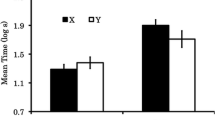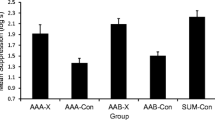Abstract
Latent inhibition (LI) is a behavioral paradigm in which prior exposure to a stimulus not followed by reinforcement retards subsequent conditioning to that stimulus when it is paired with reinforcement. Two experiments investigated the effects of 0.1 mg/kg haloperidol administration on LI as a function of number of CS pre-exposures. The investigation was carried out using a conditioned emotional response (CER) procedure consisting of three stages: pre-exposure, in which the to-be-conditioned stimulus, tone, was repeatedly presented without reinforcement; conditioning, in which the pre-exposed stimulus was paired with shock; and test, where LI was indexed by animals' suppression of licking during tone presentation. The three stages were conducted 24 h apart. In Experiment 1, 40 CS pre-exposures were given. LI was obtained in both the placebo and haloperidol conditions, but the effect was much more pronounced under the drug. Experiment 2 used ten CS pre-exposures. LI was not obtained in the placebo animals but was clearly evident in animals injected with haloperidol. The implications of these findings for the effects of neuroleptics on learning are discussed.
Similar content being viewed by others
References
Ahlenius S, Engel J, Zoller M (1977) Effects of apomorphine and haloperidol on exploratory behavior and latent learning in mice. Physiol Psychol 5:290–294
Anden NE, Butcher SG, Corrodi H, Fuxe K, Ungerstedt U (1970). Receptor activity and turnover of dopamine and noradrenaline after neuroleptics. Eur J Pharmacol 11:303–314
Anisman H, Zacharko RM (1982) Stimulus change influences escape performance: Deficits induced by uncontrollable stress and by haloperidol. Pharmacol Biochem Behav 17:263–269
Anisman H, Remington G, Sklar LS (1979) Effects of inescapable shock on subsequent escape performance: Catecholaminergic and cholinergic mediation of response initiation and maintenance. Psychopharmacology 61:107–124
Beninger RJ (1983) The role of dopamine in locomotor activity and learning. Brain Res Rev 6:173–196
Beninger RJ, Freedman NL (1982) The use of two operants to examine the nature of pimozide-induced decreases in responding for brain stimulation. Physiol Psychol 10:409–412
Beninger RJ, MacLennan AJ, Pinnel JPJ (1980a) The use of conditioned defensive burying to test the effects of pimozide on associative learning. Pharmacol Biochem Behav 12:445–448
Beninger RJ, Mason ST, Phillips AG, Fibiger HC (1980b) The use of extinction to investigate the nature of neuroleptic-induced avoidance deficits. Psychopharmacology 69:11–18
Beninger RJ, Mason ST, Phillips AG, Fibiger HC (1980c) Use of conditioned suppression to evaluate the nature of neuroleptic-induced avoidance deficits. J Pharmacol Exp Ther 213:623–627
Beninger RJ, Phillips AG (1981) The effects of pimozide during pairing on the transfer of classical conditioning to an operant discrimination. Pharmacol Biochem Behav 14:101–105
Braff DL and Sacuzzo DP (1982) Effect of antipsychotic medication on speed of information processing in schizophrenic patients. Am J Psychiatry 139:1127–1130
Cheal M (1984) Differential effects of haloperidol and clozapine on attention. Psychopharmacology 84:268–273
Corradini A, Tombaugh TN, Anisman H (1984) Effects of pimozide on escape and discrimination performance in a water-escape task. Behav Neurosci 98:96–106
Crow TJ, Cross AJ, Johnstone EC, Longden A, Owen F, Ridley RM (1980). Time course of the antipsychotic effect in schizophrenia and some change in post-mortem brain and their relations to neuroleptic medication. In: Cattabeni F, Racagni G, Spano PF, Costa E (eds) Long-term effects of neuroleptics. Raven, New York, pp 495–503
Crowell CR, Anderson DC (1972) Variations in intensity, interstimulus interval and interval between CS exposure and conditioning with rats. J Comp Physiol Psychol 79:291–298
Ettenberg A, Koob GF, Bloom FE (1981) Response artifact in the measurement of neuroleptic-induced anhedonia. Science 213:357–359
Fibiger HC (1978) Drugs and reinforcement: A critical review of the catecholamine theory. Annu Rev Pharmacol Toxicol 18:37–56
Fibiger HC, Zis AP, Phillips AG (1975) Haloperidol induced disruption of conditioned avoidance responding: Attenuation by prior training or by anti-cholinergic drugs. Eur J Pharmacol 30:309–314
Franklin KBJ, McCoy SN (1979) Pimozide-induced extinction in rats: stimulus control of responding rules out motor deficit. Pharmacol Biochem Behav 11:71–75
Groves PM, Rebec GV (1976) Biochemistry and behavior: Some central actions of amphetamines and antipsychotic drugs. Annu Rev Psychol 27:91–127
Harvey JA, Gormezano I (1981) Effects of haloperidol and pimozide on classical conditioning of the rabbit nictitating membrane response. J Pharmacol Exp Ther 218:712–719
Joseph MH, Frith CD, Waddington JL (1979) Dopaminergic mechanisms and cognitive deficit in schizophrenia. Psychopharmacology 63:273–280
Kamin LJ (1969) Predictability, surprise, attention and conditioning. In: Campbell BA, Church RM (eds) Punishment and aversive behavior. Appleton, New York, pp 279–296
Kornetzky C (1972) The use of simple test of attention as a measure of drug effects in schizophrenic patients. Psychopharmacologia 24:99–106
Kuczenski R (1983) Biochemical actions of amphetamine and other stimulants. In: Creese I (ed) Simulants: Neurochemical, behavioral and clinical perspectives. Raven, New York, pp 31–62
Lubow RE (1973) Latent inhibition. Psychol Bull 79:398–407
Lubow RE, Weiner I, Schnur P (1981) Conditioned attention theory. In: Bower GH (ed) The psychology of learning and motivation, vol. 15. Academic Press, New York, pp 1–49
Mackey WB, van der Kooy D (1985) Neuroleptics block the positive reinforcing effects of amphetamine but not of morphine as measured by place conditioning. Pharmacol Biochem Behav 22:101–105
Mackintosh NJ (1973) Stimulus selection: learning to ignore stimuli that predict no change in reinforcement. In: Hinde RA, Hinde JS (eds) Constraints on learning: limitations and predispositions. Academic Press, Cambridge, England, pp 79–100
Mackintosh NJ (1975) A theory of attention: variations in the associability of stimuli with reinforcement. Psychol Rev 82:276–298
Mackintosh NJ (1983) Conditioning and associative learning. Oxford University Press, New York
Maloney MP, Sloane RB, Whipple K, Razani J, Eaton EM (1976) Auditory attention in process and reactive schizophrenics. Biol Psychiatry 11:325–335
Mason ST, Beninger RJ, Fibiger HC, Phillips AG (1980) Pimozide-induced suppression of responding: Evidence against a block of food reward. Pharmacol Biochem Behav 12:917–923
Moore JW (1979) Brain processes and conditioning. In Dickinson A, Boakes RA (eds) Mechanisms of learning and motivation: a memorial volume for Jerzy Konorski. Earlbaum, Hillsdale, pp 111–142
Oltmanns TF, Ohayon J, Neale JM (1978) The effect of antipsychotic medication and diagnostic criteria on distractibility in schizophrenia. J Psychiatr Res 14:81–91
Orzack MH, Kornetsky C, Freeman H (1967) The effects of daily administration of carphenazine on attention in the schizophrenic patient. Psychopharmacologia 11:31–36
Pearce JM, Hall GA (1980) A model of Pavlovian learning: Variations in the effectiveness of conditioned but not of unconditioned stimuli. Psychol Rev 87:532–552
Pfautz PL, Donegan NH, Wagner AR (1978) Sensory preconditioning versus protection from habituation. J Exp Psychol [Anim Behav] 4:286–295
Phillips AG, Fibiger HC (1979) Decreased resistance to extinction after haloperidol: Implications for the role of dopamine in reinforcement. Pharmacol Biochem Behav 10:751–760
Phillips AG, McDonald AC, Wilkie DM (1981) Disruption of autoshaped responding to a signal of brain-stimulation reward by neuroleptic drugs. Pharmacol Biochem Behav 14:543–548
Rappaport M, Silverman J, Hopkins HK, Hall K (1971) Phenothiazine effects on auditory signal detection in paranoids and paranoid schizophrenics. Science 174:723–725
Reiss S, Wagner AR (1972) CS habituation produces a “latent inhibition effect” but no active “conditioned inhibition.” Learn Motiv 3:237–245
Rescorla RA (1969) Pavlovian conditioned inhibition. Psychol Bull 72:77–94
Rescorla RA (1971) Summation and retardation tests of latent inhibition. J Comp Physiol Psychol 75:77–81
Schnur P, Lubow RE (1976) Tests of the conditioned attention theory of latent inhibition: The effects of ITI and CS intensity during preexposure. Learn Motiv 7:540–550
Solomon PR, Station DM (1982) Differential effects of microinjections of d-amphetamine into the nucleus accumbens or the caudate putamen on the rat's ability to ignore an irrelevant stimulus. Biol Psychiatry 17:743–756
Solomon PR, Lohr CA, Moore JW (1974) Latent inhibition of the rabbit's nictitating response: Summation tests for active inhibition as a function of a number of CS preexposures. Bull Psychon Soc 4:557–559
Solomon PR, Crider A, Winkelman JW, Turi A, Kamer RM, Kaplan LJ (1981) Disrupted latent inhibition in the rat with chronic amphetamine or haloperidol-induced supersensitivity: relationship to schizophrenic attention disorder. Biol Psychiatry 16:519–537
Spohn HE, Lacoursiere RB, Thompson K, Coyne L (1977) Phenothiazine effects on psychological and psychpharmacological dysfunction in chronic schizophrenics. Arch Gen Psychiatry 34:633–644
Spyraki C, Fibiger HC, Phillips AG (1982) Attenuation of place preference conditioning using food reinforcement. Psychopharmacology 77:379–382
Taylor JR, Robbins TW (1984) Enhanced behavioral control by conditioned reinforcers following microinjections of d-amphetamine into the nucleus accumbens. Psychopharmacology 84:405–412
Thompson RF (1972) Sensory preconditioning. In Thompson RF, Voss MR (eds) Topics in learning and performance. Academic Press, New York
Tombaugh TN, Anisman H, Tombaugh J (1980) Extinction and dopamine receptor blockade after intermittent reinforcement training: Failure to observe functional equivalence. Psychopharmacology 70:19–28
Tombaugh TN, Tombaugh J, Anisman H (1979) Effects of dopamine receptor blockade on alimentary behaviors: Home cage food consumption, magazine training, operant acquisition, and performance. Psychopharmacology 66:219–225
Wagner AR (1976) Priming in STM: An information processing mechanism for self-generated and retrieval-generated depression in performance. In: Tighe TJ, Leaton RN (eds) Habituation: Perspectives from child development, animal behavior, and neurophysiology. Erlbaum, Hillsdale, pp 95–128
Wagner AR (1978) Expectancies and the priming of STM. In: Hulse SH, Fowler H, Honig WK (eds) Cognitive processes in animal behavior. Erlbaum, Hillsdale, pp 177–209
Wagner AR, Rescorla RA (1972) Inhibition on Pavlovian conditioning: Application of a theory. In: Boakes RA, Halliday MS (eds) Inhibition and learning. Academic Press, London, pp 301–336
Weiner I, Lubow RE, Feldon J (1981) Chronic amphetamine and latent inhibition. Behav Brain Res 2:285–286
Weiner I, Lubow RE, Feldon J (1984) Abolition of the expression but not the acquisition of latent inhibition by chronic amphetamine in rats. Psychopharmacology 83:194–199
Wise RA (1978) Catecholamine theories of reward: A critical review. Brain Res 152:215–247
Wise RA (1982) Neuroleptics and operant behavior. Behav Brain Sci 5:39–87
Author information
Authors and Affiliations
Rights and permissions
About this article
Cite this article
Weiner, I., Feldon, J. Facilitation of latent inhibition by haloperidol in rats. Psychopharmacology 91, 248–253 (1987). https://doi.org/10.1007/BF00217073
Received:
Revised:
Issue Date:
DOI: https://doi.org/10.1007/BF00217073




